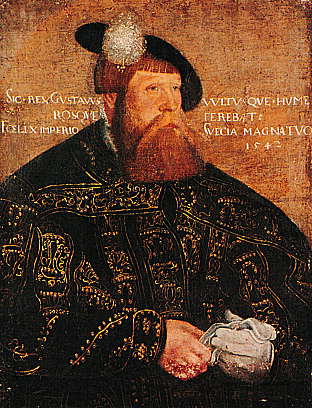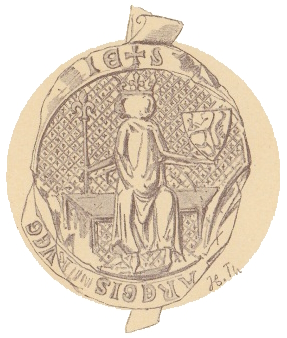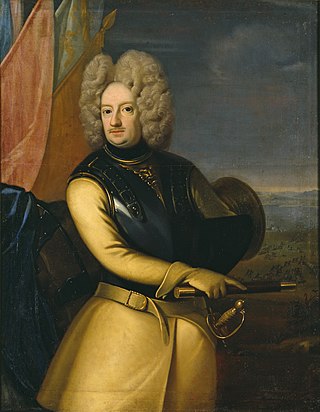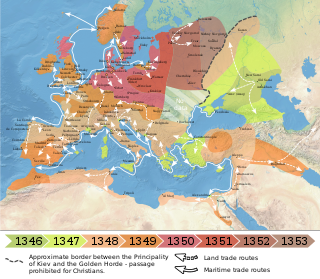Year 1341 (MCCCXLI) was a common year starting on Monday of the Julian calendar.

Gustav I, commonly known as Gustav Vasa, was King of Sweden from 1523 until his death in 1560, previously self-recognised Protector of the Realm (Riksföreståndare) from 1521, during the ongoing Swedish War of Liberation against King Christian II of Denmark, Norway and Sweden. Gustav rose to lead the Swedish War of Liberation following the Stockholm Bloodbath, where his father was executed. Gustav's election as king on 6 June 1523 and his triumphant entry into Stockholm eleven days later marked Sweden's final secession from the Kalmar Union.

Magnus Eriksson was King of Sweden from 1319 to 1364, King of Norway as Magnus VII from 1319 to 1355, and ruler of Scania from 1332 to 1360. By adversaries he has been called Magnus Smek.

Haakon VI, also known as Håkan Magnusson, was King of Norway from 1343 until his death and King of Sweden between 1362 and 1364. He is sometimes known as Haakon Magnusson the Younger to distinguish him from his great-grandfather, Haakon V.

Magnus Haakonsson was King of Norway from 1263 to 1280. One of his greatest achievements was the modernisation and nationalisation of the Norwegian law-code, after which he is known as Magnus the Lawmender. He was the first Norwegian monarch known to have used an ordinal number, although originally counting himself as "IV".

Count Magnus Stenbock was a Swedish field marshal (Fältmarskalk) and Royal Councillor. A commander of the Carolean Army during the Great Northern War, he was a prominent member of the Stenbock family. He studied at Uppsala University and joined the Swedish Army during the Nine Years' War, participating in the Battle of Fleurus in 1690. After the battle, he was appointed lieutenant colonel, entered Holy Roman service as Adjutant General, and married Eva Magdalena Oxenstierna, daughter of statesman Bengt Gabrielsson Oxenstierna. Returning to Swedish service he received colonelcy of a regiment in Wismar, and later became colonel of the Kalmar and then Dalarna regiments.

Knut Eriksson, also known as Canute I, was King of Sweden from 1173 to 1195. He was a son of King Erik the Saint and Queen Christina, who was a granddaughter of the Swedish king Inge the Elder.

Euphemia of Sweden was a Swedish princess. She was Duchess consort of Mecklenburg, heiress of Sweden and of Norway, and mother of King Albert of Sweden. (c. 1338-1412) .
Medieval Scandinavian law, also called North Germanic law, was a subset of Germanic law practiced by North Germanic peoples. It was originally memorized by lawspeakers, but after the end of the Viking Age they were committed to writing, mostly by Christian monks after the Christianization of Scandinavia. Initially, they were geographically limited to minor jurisdictions (lögsögur), and the Bjarkey laws concerned various merchant towns, but later there were laws that applied to entire Scandinavian kingdoms. Each jurisdiction was governed by an assembly of free men, called a þing.

The law of Sweden is a civil law system, whose essence is manifested in its dependence on statutory law. Sweden's civil law tradition, as in the rest of Europe, is founded upon Roman law as codified in the Corpus Juris Civilis, but as developed within German law, rather than upon the Napoleonic Code. But, over time Sweden along with the other Scandinavian countries have deviated significantly from their classical Roman and German models. Instead, the Scandinavian countries together with Finland, the Faroe Islands, Greenland, Åland (self-governing) and Iceland may be said to have a special "Nordic" version of jurisprudence that is neither a truly civil law system nor a part of the British-derived common law legal system.

The status and rights of Women in Sweden has changed several times throughout the history of Sweden. These changes have been affected by the culture, religion and laws of Sweden, as well as social discourses like the strong feminist movement.

Events from the year 1736 in Sweden
The Civil Code of 1734, was a code of law passed by the Swedish Riksdag of the Estates in 1734, and put in effect after it had been ratified by Frederick I of Sweden 23 January 1736. It became the foundation of the later civil code in Sweden – and remained so in Finland when annexed by the Russian Empire in 1809; though many alterations have been made in both Sweden and Finland since. The current Swedish Code of Statutes is founded on the civil code of 1734.
Events from the year 1618 in Sweden
Events from the year 1608 in Sweden
Kristofers landslag was a code of law passed under Christopher of Bavaria as king of Sweden in 1442. It was an amended version of the original national law, the Magnus Erikssons landslag from circa 1350. It was in effect in Sweden until the Civil Code of 1734.

Magnus Erikssons landslag, also known as simply the Landslagen, was a Swedish code of law passed by King Magnus Eriksson around 1341. It was the first attempt to apply a legal code to the entire nation of Sweden, replacing the previous local county laws under medieval Scandinavian law. The Country Law applied to the entire countryside, but not to the cities, which were governed according to the Stadslagen, which were issued in about the same time, but were separate. Kristofers landslag from 1442 was an amended version this law, in effect in Sweden until the Civil Code of 1734.
Scandinavian law, also known as Nordic law, is the law of the five Nordic countries, namely Denmark, Finland, Iceland, Norway and Sweden. It is generally regarded as a subgroup of civil law or as an individual legal body in itself. Prior to the 19th century, the European countries were independent in their administering and legality. However, in 1872, the Nordic countries organised legislative cooperation. Especially in areas of contracts and commerce, as well as those concerned with family, nationality and extradition, the five states have obtained uniform legislation.
The Law of Uppland was the law that applied in Uppland, Sweden, from 1296 to the beginning of the 1350s.

The Black Death was present in Sweden between 1350 and 1351. It was a major catastrophe which was said to have killed a third of the population, and Sweden was not to recover fully for three hundred years.












